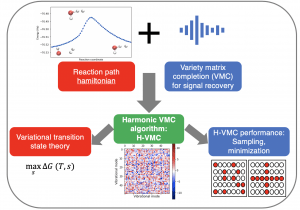Chemical reactions lie at the heart of processes designed to meet our growing energy and material needs. The first step towards designing and optimizing chemical reactions involves identification of underlying mechanisms and quantification of rates. Quantum chemistry methods along with theories such as transition state theory (TST) are indispensable for this purpose and have played a pivotal role in elucidating mechanisms and designing reaction pathways in recent decades. While widely successful, conventional TST is relatively simplistic and can lead to inaccurate rates for many classes of reactions. Alternative, more accurate rate theories such as variational transition state theory (VTST) are well-established but incur exceptionally high computational costs which limits their widespread use.
This project aims to lower these costs, thereby enhancing the reliability of rate predictions, by adapting algorithms typically used in signal processing and information recovery. Matrix completion methods are widely used to recover signals from noisy, incomplete data with high fidelity. Matrix completion has been previously used to solve the Netflix problem: determining recommendations for films based on incomplete information of a user’s preferences by exploiting information about the preferences of others with similar tastes. Here, these methods will be employed as cost-reduction strategies, to recover otherwise expensive second derivatives of energy for points on the minimum energy path (MEP) of a reaction. The algorithm, termed harmonic variety-based matrix completion (HVMC), will utilize the underlying polynomial structure of potential energies of points on the MEP, and construct a low-rank problem. A small fraction of the elements will be computed (sampled) using finite differences of gradients, available at low-cost, and HVMC will complete the missing information by exploiting our proposed matrix recovery methods. Based on the accuracy of resulting rate predictions for model reactions, this project will leverage additional problem features to further enhance algorithm efficiency. Through these efforts and a Python implementation of HVMC compatible across multiple quantum chemistry software, accurate rate theories at reduced computational effort will be made available to the scientific community to study and design chemical reactions.
Students: Selin, Kareesa
Support: Department of Energy
